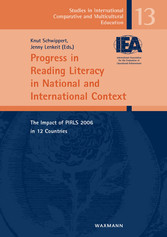Suchen und Finden
Service
Mehr zum Inhalt

Progress in Reading Literacy in National and International Context. The Impact of PIRLS 2006 in 12 Countries
Contents
6
Foreword
8
Chapter 1 Introduction
10
1.1 Overview
10
1.2 PIRLS 2001 and 2006
10
1.3 Relevance and Benefit of Large-Scale Assessments in Education
13
1.4 The Impact of PIRLS Project
18
1.5 Structure of the Book
21
Chapter 2 PIRLS 2006 in Brief
24
2.1 Introduction
24
2.2 Assessing Reading Literacy in PIRLS 2006
25
2.3 The PIRLS 2006 Target Population
28
2.4 PIRLS 2006 International Findings
29
2.5 Conclusion
43
Chapter 3 The Impact of PIRLS in Austria
48
3.1 Austria at a Glance1
48
3.2 Austria’s Education System as a Context for PIRLS
48
3.3 Austria’s Participation in Large-Scale Assessments
51
3.4 PIRLS 2006: National Results
53
3.6 The Impact of PIRLS 2006
56
3.7 Future Activities
58
3.8 Concluding Remarks
59
Chapter 4 The Impact of PIRLS in Belgium (Flemish)
62
4.1 Belgium and Flanders at a Glance
62
4.2 The Education System in Flanders
63
4.3 Experience with Large-Scale Assessments
65
4.4 National Results and the Impact of PIRLS
68
4.5 Conclusion
72
Chapter 5 The Impact of PIRLS in England
76
5.1 A Short Country Description
76
5.2 England’s Education System
76
5.3 The Country’s Current National Assessment System
77
5.4 The Country’s Experience in International Large-Scale Assessments
78
5.5 National Results, Impact, and (Expected) Long-Term Effects of PIRLS 2001 and 2006 Since the First Publication
79
5.6 Expected Future Activities
83
5.7 Concluding Remarks
83
Chapter 6 The Impact of PIRLS in Germany
86
6.1 A Short Country Description: Germany at a Glance
86
6.2 Germany’s Education System as a Context for PIRLS
87
6.3 Experience with Large-Scale Assessments
88
6.4 National Results and the Impact of PIRLS
92
6.5 Future Activities
99
6.6 Concluding Remarks
101
Chapter 7 The Impact of PIRLS in the Hong Kong Special Administrative Region of China
108
7.1 Hong Kong at a Glance
108
7.2 Hong Kong’s Education System as a Context for PIRLS
108
7.3 Experience with Large-Scale Assessments
111
7.4 National Results and Impact of PIRLS
113
7.5 Impact of PIRLS 2006
116
7.6 Anticipated Future Activities
124
7.7 Concluding Remarks
124
Chapter 8 The Impact of PIRLS in Hungary
130
8.1 Hungary at a Glance
130
8.2 Hungary’s Education System as a Context for PIRLS
130
8.3 Hungary’s Experience of Large-Scale Assessments
132
8.4 National Results
134
8.5 Impact of PIRLS
136
8.6 Future Activities
137
8.7 Concluding Remarks
138
Chapter 9 The Impact of PIRLS in Latvia
140
9.1 Latvia at a Glance
140
9.2 Latvia’s Education System
141
9.3 Participation in Large-Scale Assessments
143
9.4 National Results and the Impact of PIRLS
144
9.5 Future Activities
148
9.6 Concluding Remarks
148
Chapter 10 The Impact of PIRLS in the Netherlands
152
10.1 The Netherlands at a Glance
152
10.2 The Netherlands’ Education System as a Context for PIRLS1
152
10.3 Experience with Large-Scale Assessments
155
10.4 PIRLS 2006: National Results
156
10.5 Impact of PIRLS 2006
158
10.6 Future Activities
160
10.7 Concluding Remarks
161
Chapter 11 The Impact of PIRLS in New Zealand
164
11.1 New Zealand at a Glance
164
11.2 New Zealand’s Education System
165
11.3 Experience in Large-Scale Assessments
169
11.4 PIRLS 2006: New Zealand Results and the Impact of PIRLS
171
11.5 Recent and Future Activities
178
11.6 Concluding Comments
179
Chapter 12 The Impact of PIRLS in the Russian Federation
184
12.1 The Russian Federation at a Glance
184
12.2 Russian Education System as a Context for PIRLS 2006
185
12.3 Russia’s Experience of National Large-Scale Assessment Programs
188
12.4 Russia’s Experience of International Large-Scale Assessment Programs
189
12.5 National Results, Impact, and Expected Long-Term Effects of PIRLS
191
12.6 Future Activities
194
12.7 Concluding Remarks
196
Chapter 13 The Impact of PIRLS in the Slovak Republic
200
13.1 The Slovak Republic at a Glance
200
13.2 The National Education System
200
13.3 Slovakia’s Experience of Large-Scale Assessments
203
13.4 National Results, Impact, and (Expected) Long-Term Effects of PIRLS
207
13.5 Expected Future Activities
210
13.6 Concluding Remarks
211
Chapter 14 The Impact of PIRLS in South Africa
212
14.1 South Africa at a Glance
212
14.2 South Africa’s Education System as a Context for PIRLS
213
14.3 South Africa’s Involvement in International and National Large-Scale Assessments of Education
215
14.4 National Results and the Impact of PIRLS
217
14.5 Future Activities
223
14.6 Concluding Comments
224
Chapter 15 The Impact of PIRLS in 12 Countries: A Comparative Summary
228
15.1 Nature and Structure of the Comparative Analysis
228
15.2 General Context Data: Countries at a Glance
229
15.3 Countries’ Education Systems as a Context for PIRLS
230
15.4 National PIRLS Results at a Glance
238
15.5 Reporting of PIRLS Results and the Impact of that Reporting
241
15.6 Impact of PIRLS
245
15.7 Concluding Comments
251
Chapter 16 Concluding Remarks
254
Bibliography of International PIRLS Publications 2001
258
Bibliography of International PIRLS Publications 2006
259
Information on the Contributing Authors
260
Alle Preise verstehen sich inklusive der gesetzlichen MwSt.









